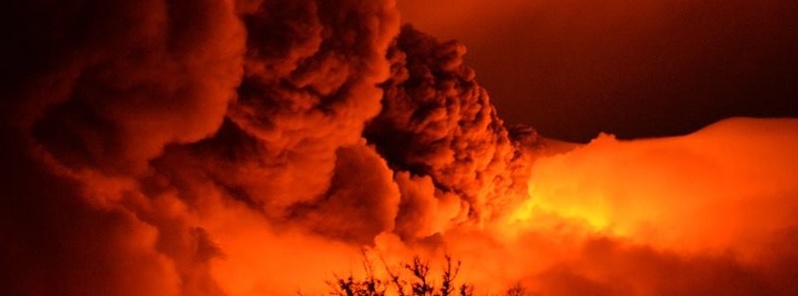Intense eruption of Italy’s Mount Etna

On Sunday, December 28, 2014 Italy's Etna volcano produced a brief but the most intense eruption of the year, the strongest since December 2, 2013.
The activity started rather abruptly at about 16:50 UTC and has rapidly intensified, accompanied by a sudden increase of volcanic tremors. After 18:30 UTC, the amplitude of volcanic tremor began to decline, and the episode was substantially completed at 20:00 UTC, Osservatorio Etneo reported.
The eruption was characterized by lava fountains and lava flows, but the very bad weather prevented clear identification of the craters involved.
Two or three lava flows descended to the east and northeast, towards the Valle del Bove. A column of gas and tephra rose few kilometers above the volcano, and was pushed by strong winds to the east.
Etna is the largest and tallest volcano of Europe, and one of the most active volcanoes on the Earth. Its eruptions occur both at the summit, where currently there are four craters, and from its flanks, down to a few hundred meters above the sea-level.
The new #paroxysm at #Etna #volcano #Sicily Photo by Alessandro Lo Piccolo pic.twitter.com/UY4lXzHcJJ
— Roberto C. Lopez (@Bromotengger) December 28, 2014
Such a great photo from @InfoSicilyIt. How I wish I could be in Catania again RIGHT NOW treking up the mountain #Etna pic.twitter.com/AiQZW8mlsS
— Wendy L. Campbell (@WendyLCampbell) December 30, 2014
Omg. The #Etna is awake #activevolcano #volcano pic.twitter.com/alBBtIhoYX
— ytulauratambien (@ytulauratambien) December 28, 2014
Mt. Etna yesterday #etna #volcano #eruption pic.twitter.com/3M4emJkB8L
— Nick Dotcom (@Nicolad76) December 29, 2014
Geologic summary
Mount Etna, towering above Catania, Sicily's second largest city, has one of the world's longest documented records of historical volcanism, dating back to 1500 BCE. Historical lava flows of basaltic composition cover much of the surface of this massive volcano, whose edifice is the highest and most voluminous in Italy. The Mongibello stratovolcano, truncated by several small calderas, was constructed during the late Pleistocene and Holocene over an older shield volcano. The most prominent morphological feature of Etna is the Valle del Bove, a 5 x 10 km horseshoe-shaped caldera open to the east. Two styles of eruptive activity typically occur at Etna.
Persistent explosive eruptions, sometimes with minor lava emissions, take place from one or more of the three prominent summit craters, the Central Crater, NE Crater, and SE Crater (the latter formed in 1978). Flank vents, typically with higher effusion rates, are less frequently active and originate from fissures that open progressively downward from near the summit (usually accompanied by strombolian eruptions at the upper end). Cinder cones are commonly constructed over the vents of lower-flank lava flows. Lava flows extend to the foot of the volcano on all sides and have reached the sea over a broad area on the SE flank.
Featured image credit: Francesco Mangiaglia (via INGV)

Commenting rules and guidelines
We value the thoughts and opinions of our readers and welcome healthy discussions on our website. In order to maintain a respectful and positive community, we ask that all commenters follow these rules.